January 23, 2005
Peregrino
So it was a slow Friday. I was catching up on some lost sleep, sealing the new panel at times, blogging and surfing along the way. I got to pick up some slack on the have-to-do's: varnishing the new coffee table with Stephanie, going out to the market, the laundry (in Catalan: "bugaderia"), stuff like that.
Moving slow.
Sometime in the afternoon, Kiko calls. Do we want to go with him on the Peregrino? Men only.
Stephanie will have to rendevous with Kiko's wife, Teresa at Bar Josep.
Sure, Kiko! ?Como no?
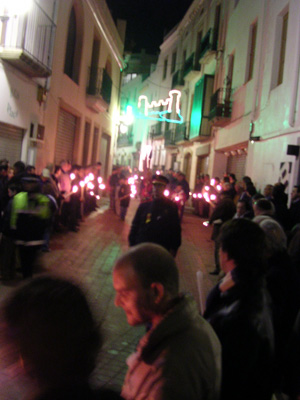
So Kiko comes by, dressed well in an trenchcoat and sweater, slacks and good shoes. I've got my grubby studio clothes on, but I throw a good coat over and pull on a ball cap (which I think ID's me as a Yanqui, no one else wears such a thing) and off we go. He's carrying a big candle, a shillelagh, which is given to me to carry in the procession.
We stopped by Mark's house. A young man, Mark was in a terrible car accident three years ago and he has recovered only part of his health as a result, which can be seen in a limp and slight speech impediment. Amiable, a perpetual smile, chatty. His mother Carmen was mopping the kitchen and we have a cortado as we wait for Mark to get ready to go out. Nice place, interesting to see the way the locals feather their nests.
As we depart, they grab their own candles stashed inside the keyboard of a piano, wicks blackened from previous years. All the while, Mark is speaking in English learned from listening to music, hablabing non stop. "It doesn't rain in Southern California" Random Pop non sequitors. Giggles. We head out into the streets for a pit stop at Bar Josep.
I describe Mark because his attitude to life was so impressive to me. He would talk of his enthusiams, watching sports until four am, young lad stuff. His nonstop stream of consciousness music lyric English joking chatter revealed someone who has seen the edge, mangled. Anything else, every day thereafter was gravy.
Kiko:See you later...Mark:
...alligator.
This, in thick Iberian accents and then they would cut up, laughing.
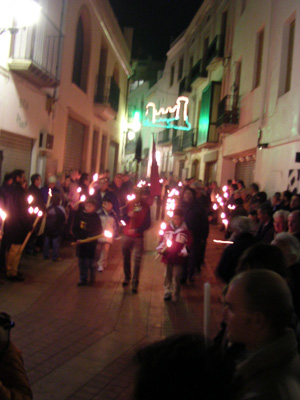
The streets are filling up with people, families and men with candles in hand, We stage ourselves at Plaza Espa?a in the center of the newer-old town. I'm seeing and greeting many familiar faces: the owner of restaruant, Can Curry, the family of Joan and Rosa, an British lad who works on the party boats there, the owner of the local gallery. I start to get the low down on this whole event.
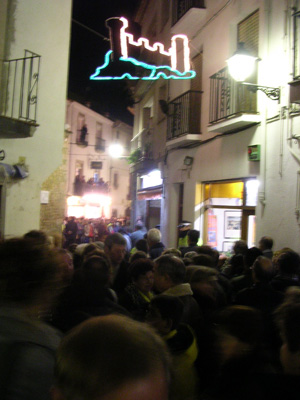
It seems that at the time of the Black Plague, there was a visit of a ship's crew, several of whom were succumbing to the Bubonic Plague.
Estimated population of Europe from 1000 to 1352.
1000 38 million
1100 48 million
1200 59 million
1300 70 million
1347 75 million
1352 50 million
25 million people died in just under five years between 1347 and 1352.
One third of the population.

The thing was, this was happening in a hush. Everybody was silent except for the ocassional whisper. You could hear the shuffling of feet and the crazy horns of the band (Medieval Catalu?an music a really whacked out sound, hard to describe and deserving of its' own blogpost) as they play an ocassional song. The hush would be broken by a priest's incantation.
Silence.
Behind the pilgrims, we fell in, candles dripping wax onto the street. We filed our way past the little chapel, up towards the walls of the old town. We stop halfway there and wait for the statue of Sanit Sebastian to be ferried by. A vocallist sang what sounded Medieval Catalan songs. Some people around me ould sang along softly, usually fathers with sons.
I link to Bococcio's Decameron:
at the beginning of the spring of that year, that horrible plague began with its dolorous effects in a most awe-inspiring manner, as I will tell you. And it did not behave as it did in the Orient, where if blood began to rush out the nose it was a manifest sign of inevitable death; but rather it began with swellings in the groin and armpit, in both men and women, some of which were as big as apples and some of which were shaped like eggs, some were small and others were large; the common people called these swellings gavoccioli. From these two parts of the body, the fatal gavaccioli would begin to spread and within a short while would appear over the entire body in various spots; the disease at this point began to take on the qualities of a deadly sickness, and the body would be covered with dark and livid spots, which would appear in great numbers on the arms, the thighs, and other parts of the body; some were large and widely spaced while some were small and bunched together. And just like the gavaciolli earlier, these were certain indications of coming death.
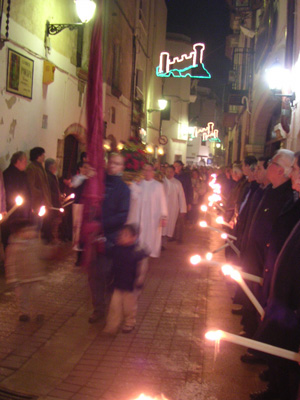
(Here comes St. Sebastian.)
Scroll further down the page, you can see the psychological effect this (epidemiological) disaster wrought:
Because of all these things, and many others that were similar or even worse, diverse fears and imaginings were born in those left alive, and all of them took recourse to the most cruel precaution: to avoid and run away from the sick and their things; by doing this, each person believed they could preserve their health. Others were of the opinion that they should live moderately and guard against all excess; by this means they would avoid infection. Having withdrawn, living separate from everybody else, they settled down and locked themselves in, where no sick person or any other living person could come, they ate small amounts of food and drank the most delicate wines and avoided all luxury, refraining from speech with outsiders, refusing news of the dead or the sick or anything else, and diverting themselves with music or whatever else was pleasant. Others, who disagreed with this, affirmed that drinking beer, enjoying oneself, and going around singing and ruckus-raising and satisfying all one's appetites whenever possible and laughing at the whole bloody thing was the best medicine; and these people put into practice what they heartily advised to others: day and night, going from tavern to tavern, drinking without moderation or measure, and many times going from house to house drinking up a storm and only listening to and talking about pleasing things. These parties were easy to find because everyone behaved as if they were going to die soon, so they cared nothing about themselves nor their belongings; as a result, most houses became common property, and any stranger passing by could enter and use the house as if he were its master. But for all their bestial living, these people always ran away from the sick. With so much affliction and misery, all reverence for the laws, both of God and of man, fell apart and dissolved, because the ministers and executors of the laws were either dead or ill like everyone else, or were left with so few officials that they were unable to do their duties; as a result, everyone was free to do whatever they pleased. Many other people steered a middle course between these two extremes, neither restricting their diet like the first group, nor indulging so liberally in drinking and other forms of dissolution like the second group, but simply not going beyond their needs or satisfying their appetite beyond the necessary, and, instead of locking themselves away, these people walked about freely, holding in their hands a posy of flowers, or fragrant herbs, or diverse exotic spices, which sometimes they pressed to their nostrils, believing it would comfort the brain with smells of that sort because the stink of corpses, sick bodies, and medicines polluted the air all about the city. Others held a more cruel opinion, one that in the end probably guaranteed their safety, saying that there was no better or more effective medicine against the disease than to run away from it; convinced by this argument, and caring for no-one but themselves, huge numbers of men and women abandoned their rightful city, their rightful homes, their relatives and their parents and their things, and sought out the countryside, as if the wrath of God would punish the iniquities of men with this plague based on where they happened to be, as if the wrath of God was aroused against only those who unfortunately found themselves within the city walls, or as if the whole of the population of the city would be exterminated in its final hour.
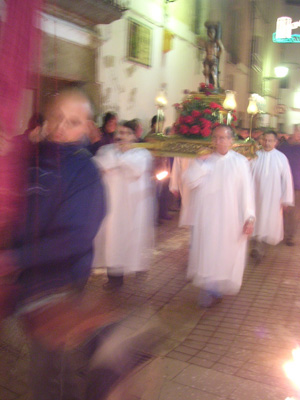
The town, Tossa, freaked out and people fled into the countryside. Now, I heard several versions of the story. In one account, one of the escaping townspeople saw a vision, an instruction to return to Tossa. They were to recover the statue of a saint that would be found behind an altar and then hang a skin of a lamb in the widow of a high tower and wait for a sign for what to do next. (Or somesuchthing, accounts vary, shoulders would shrug.)
This person, a woman, did as she was instructed and in time, saw a darkening of the skin in the particular direction of the town of Santa Coloma. (?) It was decided that a pilgrimage to this town and back is just what the everlasting doctor ordered.
And they have been at this ever since, a 650 year reverberation.
This is an petition for absolution perhaps, a deliverance from hardship. Pilgrims walk 40 kilometers and back, some barefooted. No one talks of details.. of what seem to be heartbreak stories.
Discretion.
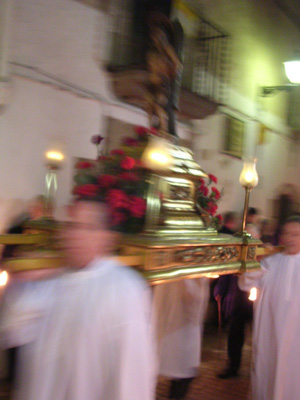
The air was blurred with smoke and candle soot.
Now what's up with Saint Sebastian?
Sebastian was named captain in the praetorian guards by Emperor Diocletian, as did Emperor Maximian when Diocletian went to the East. Neither knew that Sebastian was a Christian. When it was discovered during Maximian's persecution of the Christians that Sebastian was indeed a Christian, he was ordered executed. He was shot with arrows and left for dead, but when the widow of St. Castulus went to recover his body, she found he was still alive and nursed him back to health. Soon after, Sebastian intercepted the Emperor, denounced him for his cruelty to Christians, and was beaten to death on the Emperor's orders.
Saint Sebastian was venerated at Milan as early as the time of St. Ambrose and was buried on the Appian Way. He is patron of archers, athletes, and soldiers, and is appealed to for protection against plagues.
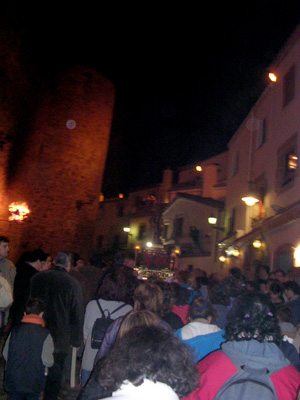
We resumed the movement alongside St. Sebastian, the walls of the Villa Vella lit by these great bonfire lamps fixed high onto the castle walls.
And finally, we round the corner of our house before we arrive at the church. I caught both our neighbor's eyes and winked to them both.
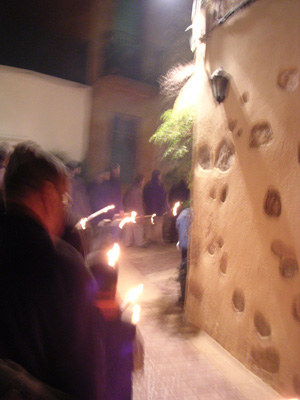
Afterwards, beers and sandwiches at Bar Josep, tons of people. We take a few people to the studio to see the work in progress, talk of art in another language sometimes funny, always hard. We finish at El Pirata, Cuban music. It was a long night with more stories to tell... but not now.
We returned home by 3:30am, an early night.
Posted by Dennis at January 23, 2005 2:26 AM
Leave a comment